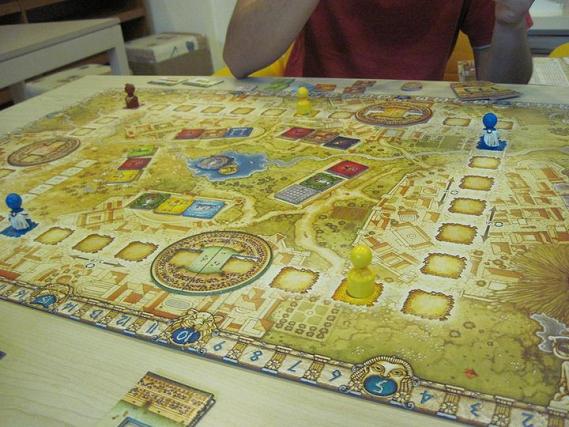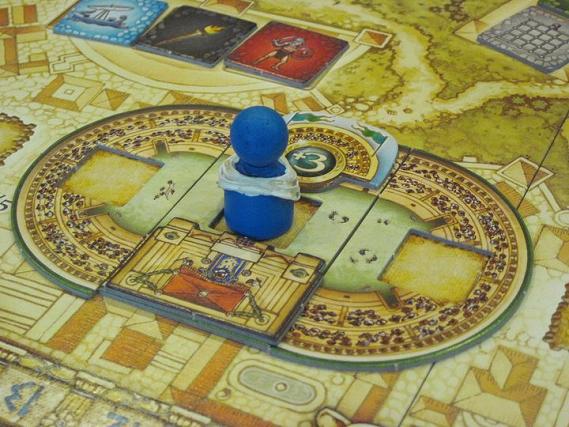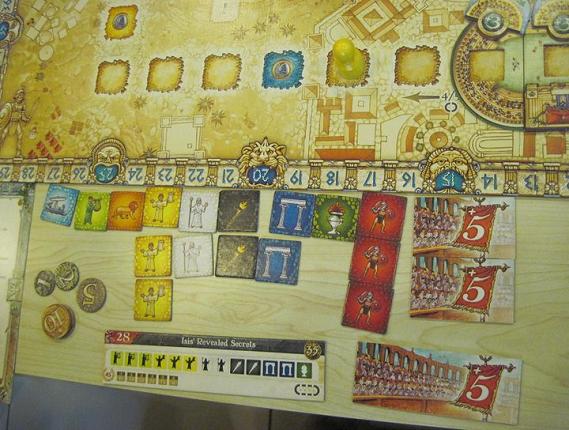
Apart from Agricola, it’s been a while since we last played a good solid Euro game. The past month has been mostly filled with children’s games, party games and Ameritrashy stuff. I’d mentioned Colosseum to Sean before because it sounded like a game with a cool theme and I guess he remembered. In this one, players are charged with presenting the best possible show for the dignitaries during the Roman era. To do this, they collect various asset tiles that can be used to mount shows, such as warriors, ships, lions, poets etc. while also expanding and renovating their respective arenas. My thoughts:
- We played the advanced variant since those were the rules that Sean described. It was just as well since the basic rules, allowing for each player to only win one auction per round, sounds far too simple, reducing the competition in the auction phase.
- One very interesting review on BGG describes this as a simplified version of Princes of Florence. It didn’t occur to me at the time, but that roughly fits. Each game even has two separate round of buying stuff. In Colosseum, you begin by taking an investment action and then proceed to bid in an auction for the asset tiles that you use to stage events. Since I like Princes of Florence anyway, I do agree that’s it the all round better game.
- One crucial difference between the two games is that in Colosseum, whenever you use the investment action to buy a new event, you can select any event. In fact, the game comes with a very handy player aid listing all of the events together with what assets are required to stage them. Technically you could start planning for which event you want to stage in the last round right from the beginning. In Princes of Florence, you need to draw the works cards from the deck.

- This game has a trading phase in which players may voluntarily exchange event assets. This makes it much easier to stage the really big events and reduces the intensity of the auctions. I’m not sure this is a good rule. Another reviewer on BGG mentioned how this can be used by players to collude against other players. This was exactly what happened in our game when Shan and I were bidding fiercely for one set of tiles. Then we discovered that each of us wanted a different item from the set so we decided to stop the bidding war and just trade instead.
- One of the novel features of this game is that only the score from the final round counts. Each event is worth its stated number of points with appropriate deductions if you stage it with less than the full set of required assets. This means that prior events serve only to beef up the main event in the final round as you get extra points for each prior completed event and to give you money to spend on each round. It’s a neat way to ensure that things are tense up to the end, so that people can’t coast to success based on an early lead.
- The main feature that is absent from Princes of Florence is the track around which the dignitaries move. Each player gets to roll a die and choose to move one of the dignitaries that many spaces. Ideally you’d want to move one of them into your own arena, which earns you extra points when you stage your event or move them into a space where you get to take a medal. These are worth a flat 3 points each or you can turn in two of them to get an extra investment action. It’s a bit of extra thematic fluff but it’s pretty random too. It also seems to make the emperor’s lodge upgrade more or less mandatory because being able to roll two dice is huge. I guess the Roman meeples are cool.
- Anyway, this was one of the rare occasions in which I actually won a game against Sean, and by a considerable margin at that. I think I had a significant advantage by being the first player in the last round of the game. This let me pick exactly the right event I needed. I also planned pretty early which events to go for, concentrating exclusively on the fighting events that needed warriors, horses, chariots etc. Sean had more event assets than anyone else, helped by the catching up mechanic of letting the player in last place steal an event asset from the leading player each round. But his assets seemed mismatched and he had a hard time completing events for their full value.
Anyway I quite enjoyed this game. While it may well be an iteration of Princes of Florence, there are worse ideas that making a lighter and more flavorful version of a good game. The theme is fantastic and I personally enjoyed reading the names of all the events, e.g. Cavalry of Spartacus, and seeing what assets are required to mount each.

Leave a Reply